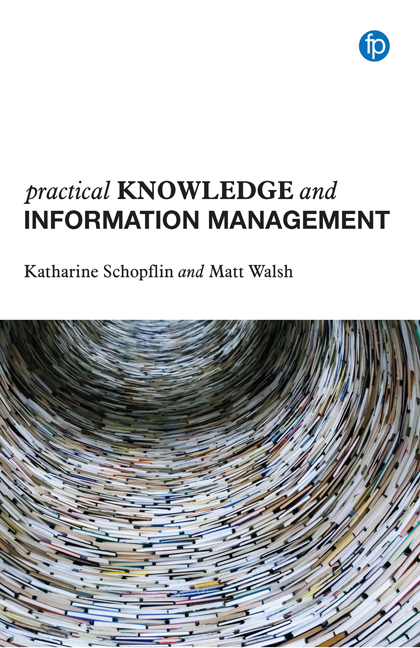Book contents
- Frontmatter
- Contents
- Case studies and sidebars
- 1 Introduction to knowledge and information management
- 2 Introducing knowledge and information management to organizations
- 3 Information management and governance
- 4 Communities and knowledge-sharing
- 5 Making knowledge explicit: knowledge bases, know-how and wikis
- 6 Capturing knowledge legacy: passing on staff knowledge
- Afterword: the future of knowledge and information management
- References
- Index
Afterword: the future of knowledge and information management
Published online by Cambridge University Press: 01 June 2019
- Frontmatter
- Contents
- Case studies and sidebars
- 1 Introduction to knowledge and information management
- 2 Introducing knowledge and information management to organizations
- 3 Information management and governance
- 4 Communities and knowledge-sharing
- 5 Making knowledge explicit: knowledge bases, know-how and wikis
- 6 Capturing knowledge legacy: passing on staff knowledge
- Afterword: the future of knowledge and information management
- References
- Index
Summary
The robots are coming…. Well, in truth they are already here and doing quite nicely. At the time of writing, one of the authors of this book was well advanced in implementing an artificial intelligence (AI) program to deliver self-service and self-help functionality to an employee portal. The project involved users engaging not with a traditional search box, or through a navigation aid, nor even connecting directly with an HR team agent, instead interrogating a chatbot. The chatbot will have direct access to the HR portal and its knowledge base, with policies and instructions, but it will also be able to query the HR engine which governs processes such as annual leave. If required, it can also interrogate the learning and development platform to point users to training manuals or courses in order to help them to complete a task. If a user asks ‘How do I find out how much leave I have?’, the chatbot will point them to their annual leave page and share a link showing how to submit annual leave requests. If they ask questions such as ‘Can I take annual leave tomorrow?’, the chatbot can bring up the relevant policy.
This fairly simple machine learning approach is just the start of what AI may be able to do to connect people to the knowledge they need. None of it is possible without the intervention of a knowledge manager to implement the business rules metadata which connect the question to the information. If you tell the bot to look for certain tags, or even natural language formulations, it can create connections both at the point of searching and by adding content to news feeds. However, beware of the salesperson who tells you their AI is capable of building the business rules and indexes for itself. The authors are yet to see a solution even close to having this capability. Like any human knowledge worker the chatbot or AI still needs to be taught. But once it learns, it can process a huge quantity of data at great speed. The next stage would be for the bot not simply to point to a relevant policy, but to actually answer the question and anticipate that the next thing the user wants to do is book some annual leave.
- Type
- Chapter
- Information
- Practical Knowledge and Information Management , pp. 108 - 112Publisher: FacetPrint publication year: 2018



